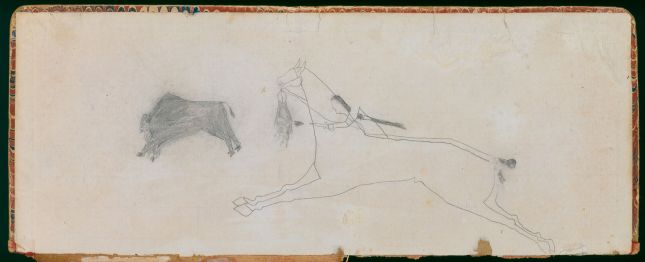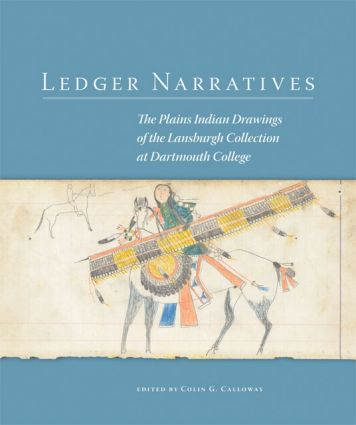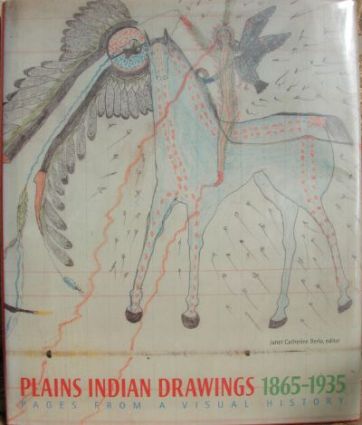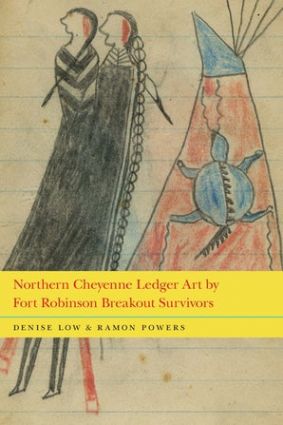
Arrow's Elk Ledger: Plate 01 Inside front cover
Media:
Dimensions:
Size: 11" x 14" (image area approx. 7" x 10").
Printed on acid free paper.
In July 1876, a month after the defeat of Custer's force at the Little Bighorn, units of the U.S. Army were hidden in ambush near the Red Cloud Agency, D.T., hoping to intercept any Sioux or Cheyenne parties which might be traveling north to join the hostile forces. Into this trap fell a small Cheyenne war party, and there ensued the famous fight during which Buffalo Bill Cody killed a warrior society chief named Yellow Hand. Posted as lookout on a hill above the hidden soldiers was a young lieutenant, who watched through binoculars the approach of the Cheyennes, and gave the signal for their destruction. Although the soldiers succeeded in routing the war party, and killing several Cheyennes, this spy was unable to restrain his admiration for the foe:
"Even four years later, the memory brings the pulse up in my throat...warfare was never more beautiful than in you. On you come, your swift, agile ponies springing down the winding ravine, the rising sun gleaming on your trailing war bonnets, on silver armlets, necklace, gorget; on brilliant painted shield and beaded leggings; on naked body and beardless face, stained most vivid vermilion. On you come, lance and rifle, pennon and feather glistening in the rare morning light, swaying in the wild grace of your peerless horsemanship..." (King, 1890: 33).
INSIDE FRONT COVER
There are an almost unlimited number of admiring eye-witness descriptions of Cheyenne riding skills. Among the first to note the Cheyennes' brilliant abilities on horseback was Edwin James, chronicler of the Stephen Long expedition. In July 1820, on the upper Arkansas river, the expedition met a camp of Hevataneo Cheyennes (Hair-rope band---named for the soft lariats they braided from buffalo hair), who had come down to the Southern Plains only two or three years previously:
"We could not but remark the ease and air of security with which the equestrians preserved their equipoise on the naked backs of their horses in their evolutions..." (James, 1923, II: 178).
This unfinished sketch, which appears on the inside front cover of the ledger, admirably captures the essence of Cheyenne riding elan. It is one of only two instances in this collection of collaboration between two artists (the other is Plate 168). The horse was drawn by the primary artist, Arrow, as we may judge by comparison with his other animals---see Plate 1, for example. The profile and open shoulder of the rider, however, are unlike any other figure in the ledger, and must be the work of another hand. The contour of the human scalp hanging from the horse's bit is also different from all other scalps depicted by Arrow. The buffalo is very different as well--- compare Plates 67, 72 and 86.
There is also here a rare instance of Arrow correcting his original concept, by redrawing the line of the horse's back. Like most Plains Indian artists, Arrow nearly always had his composition firmly in mind, and expressed it without a single errant line.
The central importance of buffalo to Plains Indian culture cannot be overstated, and is explored in detail in many ethnological accounts (see Grinnell, 1923, I: 254-55; 262-273, for example). As an introduction to the Cheyenne experiences depicted in this collection, it may be helpful to recall very briefly the astonishing number of buffalo which were the reality at the heart of the Cheyenne world. Precisely during the period depicted in these drawings, Col. Richard I. Dodge was serving in the country of the Southern Cheyennes, and preserved an eye-witness description:
"From 1869 to 1873 I was stationed at various posts along the Arkansas River. Early in the spring, as soon as the dry and apparently desert prairie had begun to change its coat of dingy brown to one of palest green, the horizon would begin to be dotted with buffalo, single, or in groups of two or three, forerunners of the coming herd. Thicker and thicker, and in larger groups they come, until by the time the grass is well up, the whole vast landscape appears a mass of buffalo, some individuals feeding, others standing, others lying down, but the herd moving slowly, moving constantly to the northward. Of their number it was impossible to form even a conjecture...
"In May 1871, I drove in a buggy from old Fort Zara to Fort Larned, on the Arkansas River. The distance is thirty-four miles. At least twenty-five miles of that distance was through an immense herd. The whole country appeared one mass of buffalo, moving slowly to the northward..." (Dodge, 1882: 283-84).


